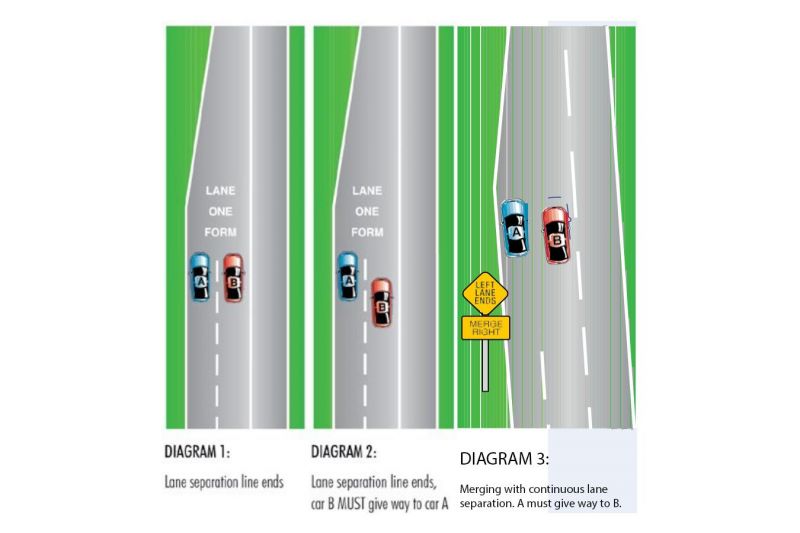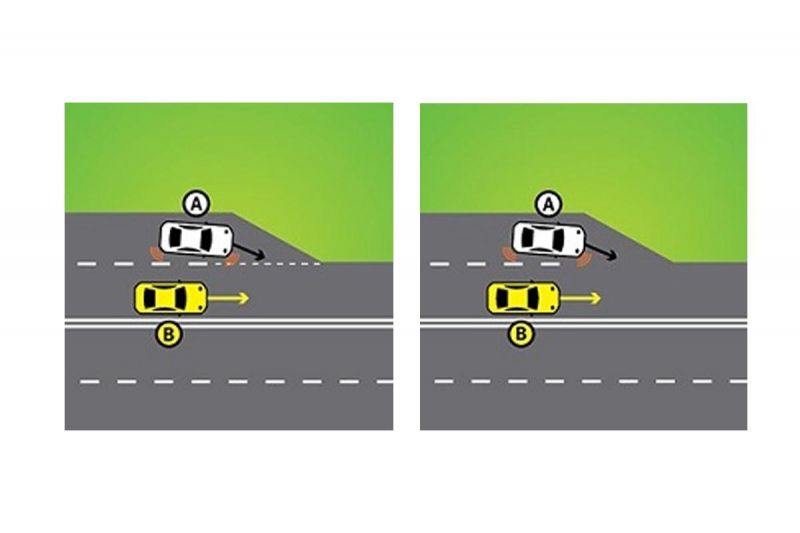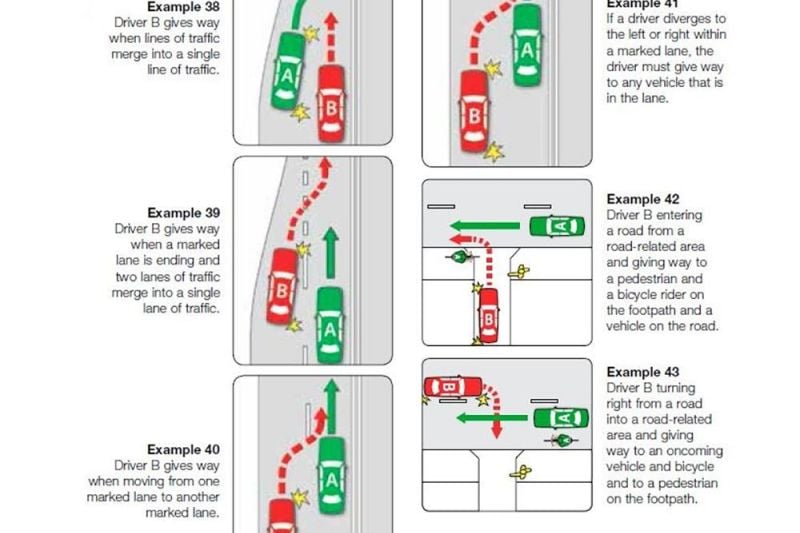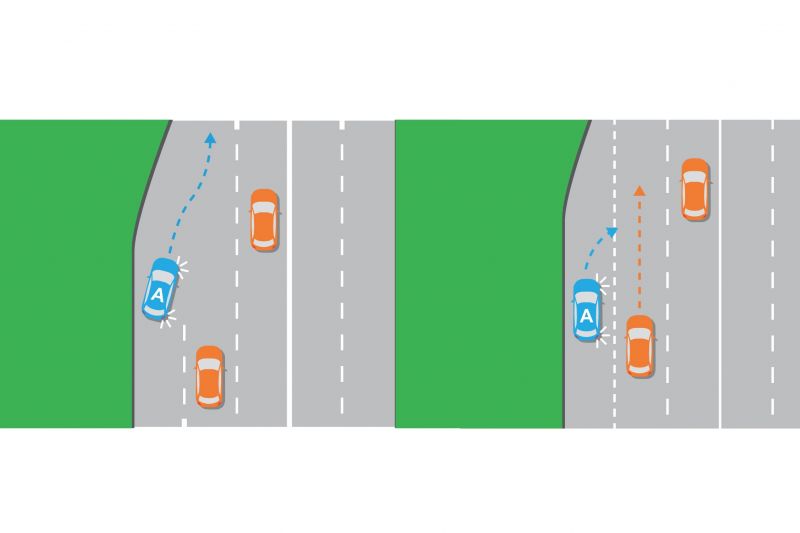Some people see indicating when merging as a common courtesy — letting other road users know that you’re planning to move across is a simple and smart thing to do.
- Merging is something a lot of people do wrong
- In some states you must indicate when merging
- There are different types of merging with different rules in different jurisdictions!
In theory it should be simple. Some newer cars have indicator stalls that are unnecessarily complicated to cancel when you try to merge… but it should be a piece of cake.
However, did you know you could be fined, and even be penalised with demerit points, for not indicating when merging? And do you know what the broken lines represent when you’re merging?
In NSW, the rules around changing lanes state that a driver “must give way to vehicles in the lane you’re moving into”, and further, that if you’re attempting to move into another lane, “you must indicate to let others know” and “make sure your indicator is off after you’ve merged or changed lanes”.
“When the lane you’re driving in is ending and you need to cross a broken line to move into another lane, you must give way to vehicles already in that lane – for example, when you’re joining a motorway.” See illustration below:
NSW Transport states: When a car is crossing a broken line to change into another lane (Car A), it must give way to vehicles already in that lane (Car B).
Most of us probably thought that the rule would be “whoever is in front gets to go”, and that seems to be the behaviour that plays out on roads around Australia. But the onus is on the merging car to ensure it is safe to do so.
If you attempt to make the move without indicating, you could be fined $194 and hit with 2 demerit points.
However, the difference between that situation and an actual ‘merge’ is the line markings on the road.
This example from NSW Transport helps show what the key difference is:
NSW Transport states: When two lanes reduce to one lane, the car trailing behind (Car B) must give way to the car ahead (Car A).
“When you’re driving on a road and the number of lanes or lines of traffic reduces, and there are no longer any road markings, you must give way to the vehicle that’s ahead of you. This is called a zipper merge,” according to the state’s transport laws.
Note that there are no indicators required for this type of merge.
The rules are the same in the Northern Territory, with slightly different wording:
“If the line ends before the lanes merge, the vehicle behind must give way to the vehicle in front. When the lane ends and you have to cross the lines to merge, you must give way.”
The fine for “fail to signal turns, change lane, stop” is $60 in the NT.
The Australian Capital Territory has a slightly different take on things, with a hardline approach to merging with its
“form one lane” road markings:
“A and B must both be prepared to give way or both may be charged following a collision.”
DIAGRAM 1: Sometimes the lane separation line will end and both lanes of traffic are required to merge into one lane. When merging in such cases, the vehicle that is ahead has the right of way over the trailing vehicle.
DIAGRAM 2: You should use care, commonsense and courtesy when merging.
Further, there are situations where the marked line continues (diagram 3), and in that instance: “Lane changing procedures are required when one lane ends and you are required to merge into another lane. This includes using your mirrors, indicators and doing a head check. If you have to cross a lane line, or merge line, you MUST give way to any vehicles in the lane that you wish to enter. You must not cross unless it is safe to do so.”
The penalty for failing to signal appropriately in the ACT is $307 and two demerit points.
In Victoria, the rules are slightly different.
VicRoads states:
- Whenever you change lanes from one marked lane to another, you must give way to vehicles already in that lane, or line of traffic. This includes merging in freeway traffic. Indicate and change lanes when there is a safe gap.
- If the lane in front of you is blocked, you must indicate and give way.
- Zip merging is where two lanes of traffic merge into one, on a road where there are no lane markings. You must give way to any vehicle which has any part of its vehicle ahead of yours.
- You are not zip merging if you cross any lines marked on the road. If you do cross lines marked on the road you must follow the give way rules for changing lanes.
Interestingly, VicRoads illustrates that even in zip merge situations, the driver ahead must indicate. If you “fail to give signal”, you could be fined $165 and cop 2 demerit points.
Queensland follows the same mindset as Victoria, with the state’s transport authority positing that all drivers must indicate when merging, whether there are lane-markings or not.
- On roads where there are lanes marked on the road—if your lane comes to an end, you must give way to traffic already in the lane you are moving to. In this example, Vehicle A (white) must give way to Vehicle B (yellow).
- On roads where there are no lanes marked on the road—when lines of traffic merge, you must give way to any vehicle that is ahead of you. In this example, Vehicle B (yellow) must give way to Vehicle A (white).
Failure to signal correctly in Queensland could net you a $92 fine and 2 demerits.
In South Australia:
- Drivers must give way to a vehicle on your left or right if any part of that vehicle is ahead of your vehicle.This is called the Zip Merge (Example 38).
- The Zip Merge does not apply where lane lines are marked between the vehicles and one lane is ending (Example 39) such as at the end of overtaking lanes and when entering the freeway.”
- If you are driving on a multi-lane road and want to move into another lane of traffic, either to your right or left, you must first check that it is safe to change lanes, give a change of direction signal clearly for long enough to warn other road users, and give way to traffic in the other lane (Examples 39 and 40). This also applies to bike lanes and where the road is wide enough for two lines of traffic but there are no lanes marked on the road (Example 41).
South Australian police could enforce a 3 demerit point, $388 penalty for “fail to give way when changing lanes”.
Tasmania police will hit you with 2 demerits and a $146 fine for failing to signal, and you could cop that fine in either of the following situations:
- Merging when the number of lanes is reduced: If you are travelling on a road without lane markings and the number of lanes or lines of traffic is reduced, you must merge by giving way to any vehicle that is ahead of you. This is often called a zip merge.
- Changing lanes when a marked lane ends: If you are travelling in a marked lane which is ending and you are required to cross a broken white line to enter the adjacent lane, you must give way to any traffic travelling in the lane being entered.
Western Australia:
- Where two lanes merge into one – that is where the lane line ends – the vehicle in front has right of way. When merging, match the legal speed of the lane you’re moving into, keep a safe distance between you and the vehicle in front of you, and in long lines of merging traffic, take turns to merge.
- If there are dual lanes, and the lane you are in ends, give way to the vehicles in the lane moving into.
WA Transport reminds motorists to “always use your indicator to signal your intentions to other drivers when merging”. The state may impose fines and demerit points, with interesting wording for the offences: Failing to give way when merging (2 points, $100); Failing to give way when changing lanes (3 points, $100).
It is always advisable to be aware of the laws and regulations applicable to the jurisdiction that you live in.
Not intended as legal advice. Check with the relevant roads authority in your state or territory.









